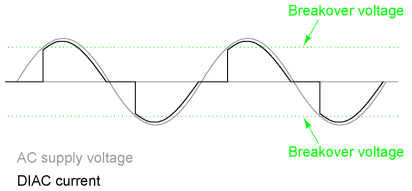| The ebook FEEE - Fundamentals of Electrical Engineering and Electronics is based on material originally written by T.R. Kuphaldt and various co-authors. For more information please read the copyright pages. |

|

Home  Semiconductors Semiconductors  Thyristors Thyristors  The DIAC The DIAC |
|






|
|
|
The DIACDIACLike all diodes, Shockley diodes are unidirectional devices; that is, they only conduct current in one direction. If bidirectional (AC) operation is desired, two Shockley diodes may be joined in parallel facing different directions to form a new kind of thyristor, the DIAC:
A DIAC operated with a DC voltage across it behaves exactly the same as a Shockley diode. With AC, however, the behavior is different from what one might expect. Because alternating current repeatedly reverses direction, DIACs will not stay latched longer than one-half cycle. If a DIAC becomes latched, it will continue to conduct current only as long as there is voltage available to push enough current in that direction. When the AC polarity reverses, as it must twice per cycle, the DIAC will drop out due to insufficient current, necessitating another breakover before it conducts again. The result is a current waveform that looks like this:
DIACs are almost never used alone, but in conjunction with other thyristor devices.
|
|
Home  Semiconductors Semiconductors  Thyristors Thyristors  The DIAC The DIAC |
|
Last Update: 2010-11-19



